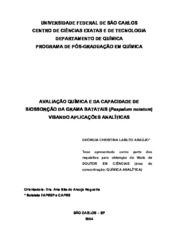Avalição química e da capacidade de biossorção da grama batatais (Paspalum notatum) visando aplicações analíticas.
Abstract
This work suggests the chemical characterization of the genus Paspalum and was divided in 3 steps: 1) sample preparation of plants with diluted acids; 2) biosorption studies employing
Paspalum notatum root material, and 3) investigation of root cellular wall constituents. Therefore, in the first step, solutions ranging from 2 to 14 mol L-1 HNO3
were used to assisted high-pressure microwave plant samples digestion. Quantitative amounts of analytes were obtained, including Fe and Al, by using 2 mL of 2 mol L-1 HNO3 solution plus 1 mL of H2O2 30 % v v-1. Residual carbon contents were ≤ 11 %. The 1H NMR spectra indicated lower variety of nitrocompounds for samples digested
with diluted acids. For the second step, sorption studies in root material leached and
no-leached with 0.14 mol L-1 HNO3 solution were performed. The sorption obtained for the former was higher than for the latter material. Sorption isotherms of Al3+, Fe3+, Cu2+ and Ni2+ in H3CCOONH4 and KNO3 environments with mono and multielemental solutions were plotted and adjusted to the more representative theoretical models for the experimental results. The KNO3 monoelemental studies presented higher sorption for Fe and Cu than for H3CCOONH4 environment, probably owing to the absence of bounding ions. Sorption has reduced for all analytes in KNO3
multielemental studies, probably owing to the competition by the sorption sites. In the
other hand, H3CCOONH4 multielemental studies showed an increasing of two times for Fe and Al sorption, probably due to lateral interactions between the analytes and the biosorbent surfaces, which were verified with sorption isotherm profiles. In the last step, the 1H NMR spectra and the potentiometric titration indicated that the acid rinsing changed the material. In this case, interpretation of the results obtained with potentiometric titration suggests the amine and phenol groups as likely sorption sites. The determination of Al, Fe, Cu, Ni, aminoacids and sugar in fractions obtained from the sequential extraction of the cell wall compounds, combined to Pearson s correlation coefficient studies, evidenced different distributions of the analytes at the fractions and material. Thus, the functional groups related to each metal could be estimated.
